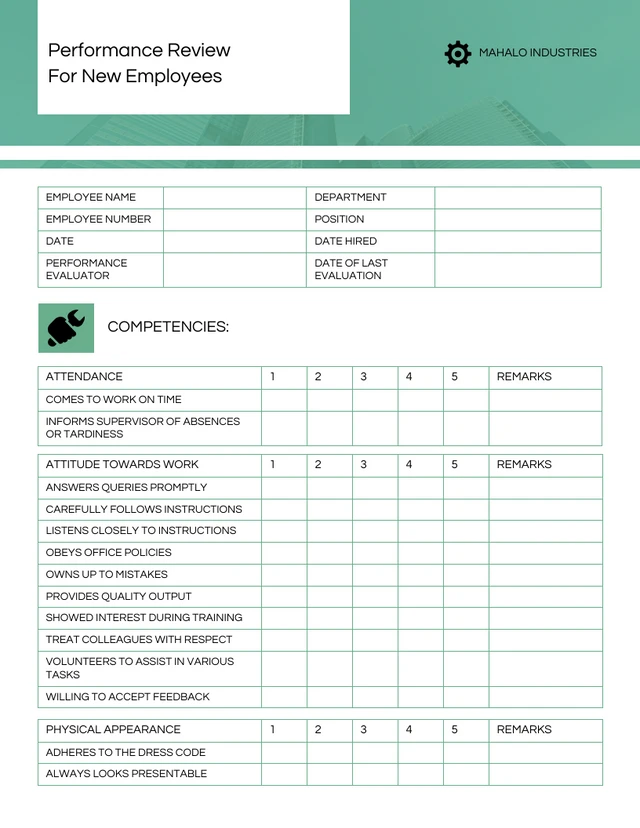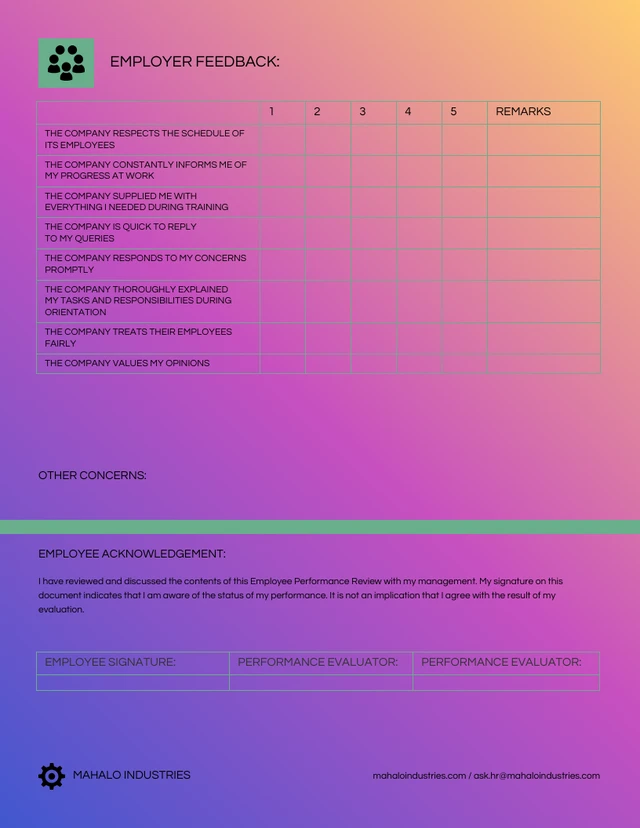Engaging Performance Review Examples [+ Tips From an NERDCORE Manager]
- Jun 27, 2024
- 7 min read

Performance review season can be a daunting period for both management and employees.
One-sided conversations, mixed messages and wordy documents leave both parties feeling like they have the same, stressful conversation each time.
But if you take the right approach, quarterly or annual performance reviews are an awesome opportunity to reinforce solid habits, redirect poor traits and drive professional growth for your employees.
In this post, I’ll give you tips from my own experience as an HR manager to make the performance review process a lot more painless, plus human resource templates you can customize now.
Engaging Performance Review Examples [+ Tips From an NERDCORE Manager]
What is a performance review?
A performance review is a regulated assessment in which managers evaluate an employee’s work performance to identify their strengths and weaknesses, offer feedback and assist with goal setting.
The frequency and depth of the review process may vary by company, based on company size and goals of the evaluations. It could be annually:


This quarterly performance review example has sections for both achievements and areas of improvement. It also has a section for core values, as this must be a key performance indicator at this company. Different companies will have different measuring sticks for success.


How to write a performance review
Having an employee-friendly performance review process can not only make or break the development of your employees but also disrupt the relationship between managers and their reports.
Beyond creating a robust performance review strategy and performance review form, managers must also consider their delivery of the appraisals. Communicating a performance review effectively is the final touch to executing a constructive, celebratory and effective review process.
When creating an effective assessment, it’s important to include the following:
Calculate an overall rating for the employee; although a manager will be highlighting both the strengths and weaknesses of an employee’s behavior, it will aid the employee’s morale to communicate how the employee averaged on this rating scale.
Ensure the employees are engaged in their own reviews; thus, be sure to include the employees’ goals and developments toward reaching such goals in the assessments.
Celebrate employees improvements; highlighting an employees’ developments are a powerful way to impact employee engagement and boost overall team performance.
Company culture and values; dedicate a section of the assessment to evaluate how employees align with the company’s core values thus contributing to a positive company culture.

Based on my involvement in building out our own effective performance review process at Venngage, I suggest taking the following steps into consideration when constructing a performance review:
1. Set expectations early
Early in an employee’s career with a company, managers should communicate the details of their review process including the expectations. It should be included in your employee handbook, for example.
In this way, managers set and communicate clear expectations of the key job functions and competencies of the role when an employee joins the company. The information presented in performance reviews should align with this define as well as use familiar language and terms. This strategy will work to eliminate any potential confusion or surprises for both parties.
2. Don’t make it personal
Feedback is about actions and behavior, not the person.
When writing a performance review, it helps to take a look at the issue(s) you’ve included and ensure that they apply to actions and behavior of the employee rather than the personal attributes of said employee.
This will also help to regulate the information mentioned in the review, to guarantee it is relevant and appropriate information.
3. Beware of biases and limitations
While there may be a general ‘right’ way of doing things, there are often multiple — and equally good — ways to reach the same end goal.
Please ensure your review is not biased or limited in favor of your personal work style and beliefs. Try to consider the various aspects of the employees role and experience that may impact their decision to pursue alternative methods or working habits. Be empathetic towards these factors when writing your review.
4. Be specific
The information presented in the review should be task-focused, clear and to the point.
General comments will leave an employee feeling confused and in the dark as to what aspect of their work needs to be corrected or how they can pursue improvements.
Failing to be direct in your messaging will impact the way your message is received and create further confusion about what the expectations are. Managers should be specific on what behaviors of their employees they are celebrating and what actions require improvements.
4. Offer guidance
Managers play a critical role in understanding the career goals of their employees and crafting development opportunities to help their reports achieve their goals.
It is important as a manager to offer your advice and expertise to your employees to help further their development.
If, as a result of the feedback given, the employee (or yourself) may feel as though they need additional training, consider the benefit of workshops, mentoring or coaching.
Be sure to use performance reviews as a way to guide employees whether it is toward further greatness or for areas requiring some improvement.
5. Follow up
Follow up in writing and check in continuously to ensure improvement.
Both managers and employees should receive a copy of the review to refer back to moving forward.
Whether reviews are scheduled annually or quarterly, they should be a continuous topic of discussion for both managers and employees. When writing a review, ensure that the review is clear and specific. Being mindful of this will help to ensure the employee can easily refer back to the form on their own after the meeting.

Performance review examples and templates
To conduct an effective performance review, it’s important to deliver a positive and solution-focused message. This will be less discouraging to the employee.
This performance review example shows how you can offer constructive feedback, while also praising the employee’s efforts. The majority of the sections focus on the employees’ achievements and strengths.
Suggested areas of improvement are positioned in the middle, letting managers cushion criticism with praise.

This appraisal example shows how managers can give constructive feedback to their employees by giving them clear direction on what things to keep doing and what actions to take in future.
While Felicia did not meet her goal, her manager acknowledges that the goal was set deliberately high and that 74 percent of the goal still has significant impact.
This employee review form also points to specific positive behavior, such as self-education, teamwork and a strong work ethic.
There are also specific recommendations for improvement, such as putting together a plan to get more press mentions and scaling her experiments.
Another way to do a performance review, or kick off the process, is to use a quadrant. Both the employee and manager can plot where they think the former falls on certain key values and build out discussion points from there.
You can change “get it done/get it right” in the employee review template below to “uphold core values/contribute to company culture” for example.

Performance review examples for managers
Performance reviews are a crucial part of effective management, offering an opportunity to provide constructive feedback and set the stage for future growth.
To conduct a successful performance review as a manager, preparation is essential. Collect and review performance data well in advance, considering both quantitative metrics and qualitative observations.

Make sure to prioritize clear and open communication. Create a comfortable and respectful environment for the discussion, allowing the employee to share their perspective and concerns.
Offering specific examples of both strengths and areas for improvement is critical, as vague feedback can lead to misunderstandings.

Additionally, focus on setting SMART (Specific, Measurable, Achievable, Relevant, and Time-bound) goals for the future, collaboratively establishing an action plan that aligns with the company’s objectives and the employee’s career aspirations.

Finally, follow up on the action plan throughout the year, providing ongoing support and feedback to ensure continuous improvement. Consistent and well-structured performance reviews contribute to employee development, job satisfaction, and overall team success.
Performance review examples for employees
Performance reviews for new employees are critical in setting the tone for their growth and integration into the organization.
For new employees especially, they may be nervous or unsure of what to expect for their first performance review. That’s why, it’s important for managers to create a welcoming and comfortable environment.
Start by acknowledging their achievements and progress since joining the company. Recognizing their early contributions can boost their confidence and motivation.
Additionally, focus on clear communication. Outline expectations and performance standards specific to their role. New employees should leave the review with a clear understanding of their job responsibilities and how their work aligns with the company’s goals.
It’s also crucial to discuss their career development. New employees often seek opportunities for advancement and growth. Use the review to explore their long-term goals within the company, and explain how their role fits into the larger career path.

Finally, emphasize ongoing support and mentorship. New employees benefit from regular check-ins and guidance to help them acclimate and succeed in their roles.
Self performance review examples
In a self-performance review, employees assess themselves using the same rubric as their managers would and submit them to HR and/or their manager prior to their official review meeting.
The benefits of doing self-assessments have made them a common part of the employee review throughout many companies.
Self-assessments are an encouraging opportunity for employees to share their thoughts about their job, goals, desired responsibilities and aspects of either their role or environment that they may be struggling with.
Set employees up for success in the self-assessment process by giving them a robust employee evaluation form with thoughtful questions, and HR tools to automate this process and make it more convenient.
Annual self-evaluation employee review template
This first example is perfect for a thorough annual review. The targeted questions prompt the employee to reflect on their achievements and shortcomings, while also rating themselves on specific skill sets required for their job.

The above employee self-assessment example allows for multiple sign-offs, plus a section to list colleagues who can back up the employee’s statements.
Yearly performance self-evaluation templates
A yearly performance self-evaluation isn’t just a great chance for employees to assess their past performance.
It’s also a way for employees to plan for their professional future as they can see where their strengths lie and what skills they need to build to move up in the company. An annual self-evaluation can also build an employee’s case for their compensation review.
This employee self-evaluation form is broken into sections that cover all these factors: about your job, achievements, goals and professional development.
The above employee self-assessment example allows for multiple sign-offs, plus a section to list colleagues who can back up the employee’s statements.
Yearly performance self-evaluation templates
A yearly performance self-evaluation isn’t just a great chance for employees to assess their past performance.
It’s also a way for employees to plan for their professional future as they can see where their strengths lie and what skills they need to build to move up in the company. An annual self-evaluation can also build an employee’s case for their compensation review.
This employee self-evaluation form is broken into sections that cover all these factors: about your job, achievements, goals and professional development.









Comments